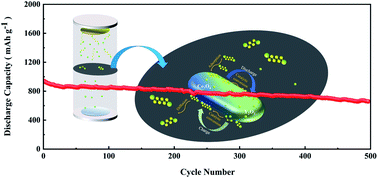A multifunctional separator modified using Y2O3/Co3O4 heterostructures boosting polysulfide catalytic conversion for advanced Li–S batteries†
Abstract
Lithium–sulfur batteries (LiSBs) have attracted extensive attention due to their low cost and high theoretical energy density (2600 W h kg−1). However, the commercial application of Li–S batteries is seriously hindered by the shuttle effect and sluggish reaction kinetics of polysulfides. To address the above problems, brand-new Y2O3/Co3O4 heterostructures were prepared and designed by a simple hydrothermal method and calcination process as a modified separator material (Y2O3/Co3O4/AB) for Li–S batteries. Moreover, the capsule-like Y2O3/Co3O4 heterostructures can trap polysulfides and catalytically convert them, originating from strong synergistic adsorption of transition metal oxides and the high-efficiency catalysis of rare-earth oxides. Herein, due to these merits, the battery with the Y2O3/Co3O4/AB modified separator exhibits a high initial discharge specific capacity of 1204 mA h g−1 and a high capacity retention of 92% after 100 cycles at 0.2C. Even at a high current density of 3C, the specific capacity can achieve 659 mA h g−1. Therefore, this work provides a promising strategy for mitigating the shuttle effect of polysulfides and lays a solid foundation for further practical application of LiSBs.



 Please wait while we load your content...
Please wait while we load your content...